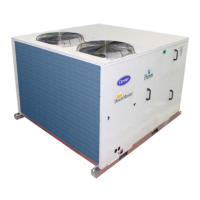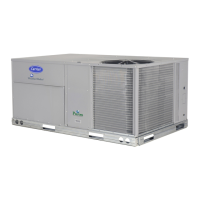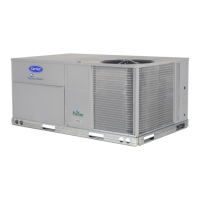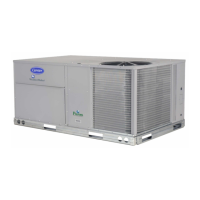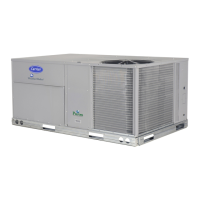Table 11 — Economizer Checkout Procedures
TEST PROCEDURE RESULTS
A. Disconnect power at
TR and TR1.
Disconnect jumper
between P and
P1. See Fig. 15.
B. Jumper TR to 1.
C. Jumper T1 to T.
D. Disconnect outdoor-air
thermostat connections
from S
O
and +.
Factory-installed
800 ohm resistor
should remain connected
to S
R
and +.
E. Reconnect power to
terminals TR and TR1.
1. LED (light-emitting diode)
should be off.
2. Motor is in closed position.
TEST PROCEDURE RESULTS
A. Disconnect
factory-installed
resistor from
terminals S
R
and +.
1. LED (light-emitting diode)
should be on.
2. Motor drives toward open.
Table 12 — High and Low Outdoor-Air
Temperature Simulation
TEST PROCEDURE RESULTS
A. Reconnect factory-
installed 800 ohm resis-
tor between terminals
S
R
and +.
B. Connect 1200 ohm
checkout resistor
between terminals
S
O
and +.
C. Turn set point poten-
tiometer to position A.
Low outdoor-air temperature
test results:
1. LED (light-emitting diode)
should be on.
2. Motor drives toward open.
D. Turn set point poten-
tiometer to position D.
E. Disconnect 1200 ohm
checkout resistor.
High outdoor-air temperature
test results:
1. LED should be off.
2. Motor drives toward closed.
5. Set the outdoor-air thermostat (OAT) located in the econo-
mizer section of the unit (see Fig. 14) to 75 F.
6. If the outdoor temperature is below 75 F, the econo-
mizer will control the mixed air with the mixed-air sen-
sor. If the outdoor air is above 75 F, place a jumper around
the contacts of the OAT.
7. Jumper terminal T to terminal T1 on the module (see
Fig. 15). The economizer will go to the full open po-
sition. The outdoor-air damper will go to the full open
position, and the return-air damper will go to the full
closed position.
8. Adjust mechanical linkage, if necessary, for correct po-
sitioning. It may be necessary to remove the filters to
adjust the linkage.
9. Remove the jumper from around the contacts of the OAT
if installed in Step 6. Remove the jumper from termi-
nals T and T1 installed in Step 7.
10. If the Cooling mode was simulated to operate the unit
in Step 4, remove the jumper and reconnect the ther-
mostat wires to terminals Y1 and Y2.
Power Failure — Dampers have a spring return. In event
of power failure, dampers will return to fully closed position
until power is restored. Do not manually operate damper
motor.
Refrigerant Charge — Amount of refrigerant charge
is listed on unit nameplate and in Table 1. Refer to Carrier
GTAC II; Module 5; Charging, Recovery, Recycling, and Rec-
lamation section for charging methods and procedures. Unit
panels must be in place when unit is operating during charg-
ing procedure.
NOTE: Do not use recycled refrigerant as it may contain
contaminants.
NO CHARGE — Use standard evacuating techniques. After
evacuating system, weigh in the specified amount of refrig-
erant (refer to Table 1).
LOW CHARGE COOLING — Using cooling charging chart
(see Fig. 30), add or remove refrigerant until conditions of
the chart are met. Note that charging chart is different from
those normally used.An accurate pressure gage and temperature-
sensing device is required. Charging is accomplished by en-
suring the proper amount of liquid sub-cooling. Measure liquid
line pressure at the liquid line service valve using pressure
gage. Connect temperature sensing device to the liquid line
near the liquid ine service valve and insulate it so that out-
door ambient temperature does not affect reading.
TO USE THE COOLING CHARGING CHART — Use the
above temperature and pressure readings, and find the in-
tersection point on the cooling charging chart. If intersection
point on chart is above line, add refrigerant. If intersection
point on chart is below line, carefully recover some of the
charge. Recheck suction pressure as charge is adjusted.
NOTE: Indoor-air CFM must be within normal operating range
of unit. All outdoor fans must be operating.
The TXV (thermostatic expansion valve) is set to main-
tain between 15 and 20 degrees of superheat at the compres-
sors. The valves are factory set and should not require
re-adjustment.
50
40
100
150
200
250
300
350
400
60
80
100
120
140
ALL OUTDOOR FANS MUST BE OPERATING
LIQUID PRESSURE AT LIQUID VALVE (PSIG)
LIQUID TEMPERATURE AT LIQUID VALVE (DEG F)
BOTH CIRCUITS
REDUCE CHARGE IF BELOW CURVE
ADD CHARGE IF ABOVE CURVE
Fig. 30 — Cooling Charging Chart
23

